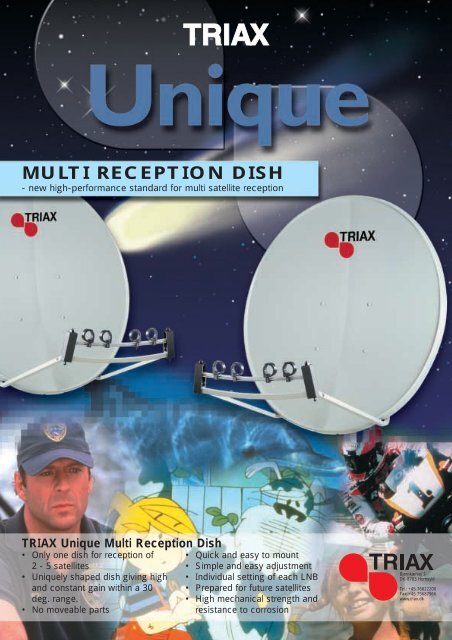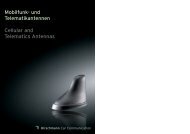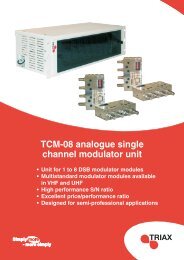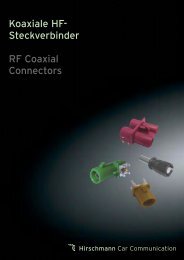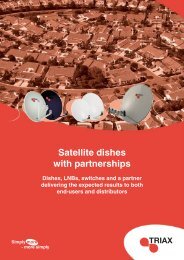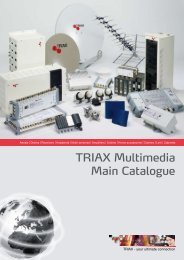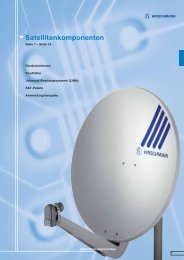Triax TD Unique.pdf
Triax TD Unique.pdf
Triax TD Unique.pdf
Create successful ePaper yourself
Turn your PDF publications into a flip-book with our unique Google optimized e-Paper software.
MULTI RECEPTION DISH<br />
- new high-performance standard for multi satellite reception<br />
TRIAX <strong>Unique</strong> Multi Reception Dish<br />
• Only one dish for reception of<br />
2 - 5 satellites<br />
• <strong>Unique</strong>ly shaped dish giving high<br />
and constant gain within a 30<br />
deg. range.<br />
• No moveable parts<br />
• Quick and easy to mount<br />
• Simple and easy adjustment<br />
• Individual setting of each LNB<br />
• Prepared for future satellites<br />
• High mechanical strength and<br />
resistance to corrosion<br />
Bjørnkærvej 3<br />
DK-8783 Hornsyld<br />
Tel.: +45 76822200<br />
Fax: +45 75687966<br />
www.triax.dk
TRIAX <strong>Unique</strong> Multi Reception Dish<br />
- a technical description<br />
Multi Satellite Reception<br />
With the increasing number of satellites follows the wish to receive signals<br />
from different (satellite) directions.<br />
There are several approaches to this, each with its own advantage and<br />
disadvantage.<br />
1) One dish for each satellite. Technically this is the best solution, as each<br />
dish can be optimized with respect to size and position. However to<br />
receive many satellites you need a lot of dishes!<br />
2) Sidemounting of LNB’s. Using this method an adjacent satellite can be<br />
received by offsetting an LNB from the true focus, thereby changing<br />
the beamdirection of the dish.<br />
However this “twisting” of the beam reduces gain - and the further<br />
away from the true focal point, the more gain is lost and so the available<br />
satellite signal. Offsetting two LNB’s symmetrically to each side of<br />
the focalpoint generally gives a better compromise, with less reduction<br />
of each signal.<br />
3) A motorized dish. With this solution one dish is covering all available<br />
satellites, however only one position can be received at a time and the<br />
installation and adjustment can be complicated.<br />
All three types of installations are used - depending on the individual<br />
requirement of the customers. And TRIAX offers the right products for<br />
each of these solutions.<br />
Fig. 1 Shows reduction in gain vs. change in azimuth beam angle on a<br />
<strong>TD</strong>78 dish with sidemounting.<br />
<strong>TD</strong> Dish 78 Reduction with offset-mounting of LNB<br />
Ref. val (dB): 37.00 - Scale/div. (dB): 1.00<br />
[dB ]<br />
0<br />
Advantage of TRIAX <strong>Unique</strong><br />
Multi Reception Dish<br />
The <strong>Unique</strong> Multi Reception Dish is the result of research into semi-parabolic<br />
shapes and the influence on available gain in both main and sidedirections.<br />
Through a special shaping we have streched the focal point into<br />
a focalline and still letting each LNB utilize all of the dish’s surface. Thus<br />
succesfully combining efficient area utilization of sidemounting with the<br />
broad and uniform azimuth beam coverage of the torus antenna.<br />
Fig. 3 TRIAX <strong>Unique</strong> Multi Reception Dish gain.<br />
<strong>TD</strong> <strong>Unique</strong> Multi Reception Dish<br />
Ref. val (dB): 37.00 - Scale/div. (dB): 1.00<br />
[dB ]<br />
0<br />
-1<br />
-2<br />
-3<br />
-4<br />
-5<br />
-30 -25 -20 -15 -10 -5 0 5 10 15 20 25 30<br />
[deg ]<br />
It is quite obvious, how the TRIAX <strong>Unique</strong> Multi Reception Dish design<br />
retains gain even at large changes of azimuth beam angles<br />
- where it really matters for multisatellite reception!<br />
-1<br />
-2<br />
-3<br />
Technical Specifications<br />
-4<br />
-5<br />
Type<br />
<strong>TD</strong> <strong>Unique</strong> Multi Reception Dish<br />
Part No.<br />
126390<br />
-30 -25 -20 -15 -10 -5 0 5 10 15 20 25 30<br />
[deg ]<br />
On a standard dish the LNB is placed in focus for best gain.<br />
A second LNB can be sidemounted for reception of an adjacent satellite.<br />
However gain is lost as this LNB is out of focus, and the losses increase<br />
dramatically with large offsets.<br />
For neighbouring satellites having 3 to 6 deg spacing this is uncritical -<br />
additional losses may be limited to 0,2 - 0,5 dB; however for separations<br />
of 10 deg or more, the losses quickly rise to 3 - 6 dB!<br />
Fig. 2 Comparison of gain distribution vs. azimuth beam angle using a<br />
standard <strong>TD</strong>78 dish and the TRIAX <strong>Unique</strong> Multi Reception Dish.<br />
Frequency range<br />
Gain (@ 11.7 GHz)<br />
X-polarisation<br />
Offset angle<br />
Reflector type<br />
Beam width<br />
10,7 - 12,75 GHz<br />
37.1 dBi<br />
> 20 dB<br />
26°<br />
Offset (F/D ratio 0.6)<br />
2.6°<br />
<strong>TD</strong>78 and <strong>TD</strong> <strong>Unique</strong> Multi Reception Dish Comparison<br />
Ref. val (dB): 37.00 - Scale/div. (dB): 1.00<br />
[dB ]<br />
Elevation range<br />
5 - 50 deg.<br />
0<br />
-1<br />
-2<br />
-3<br />
LNB adjustment<br />
(azimuth)<br />
Material<br />
+/- 17 deg.<br />
Pregalvanised steel<br />
-4<br />
-5<br />
-30 -25 -20 -15 -10 -5 0 5 10 15 20 25 30<br />
[deg ]<br />
There are certain antenna designs, where several LNB’s may be placed<br />
next to each other for multi satellite reception without change in individual<br />
performance. One such design is the torus dish, which has a rectangular<br />
reflector using a combination of a parabolic and circular shape.<br />
This design has the advantage that the focuses are placed on a line in<br />
front of the dish, where all LNB’s are placed. The disadvantage is, that<br />
each LNB only utilizes a minor part of the reflector, and as a consequence<br />
the gain is equivalent to that of a smaller dish.<br />
Finish<br />
LNB holder<br />
Size (w x h)<br />
Weight (kg)<br />
Windload (42m/s)<br />
Mast dimension<br />
Wall bracket<br />
Chromate, polyester powder coat<br />
Plastic feed holder<br />
Ø25/Ø40<br />
100 x 111 cm<br />
11<br />
950N<br />
Ø 28-Ø 63 mm<br />
- optional extra<br />
AB.17.4.02


